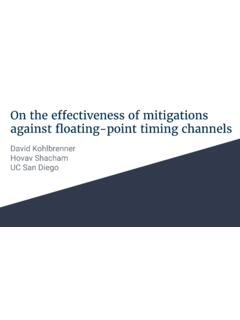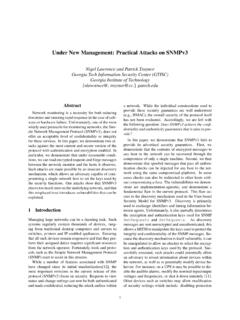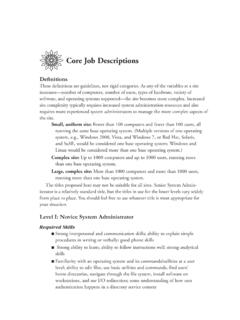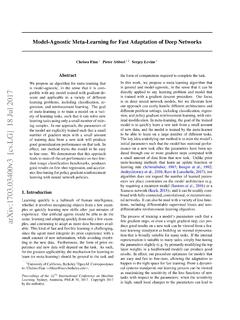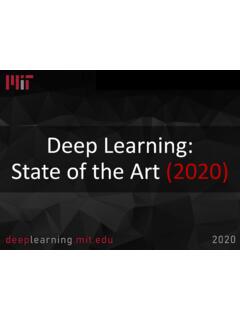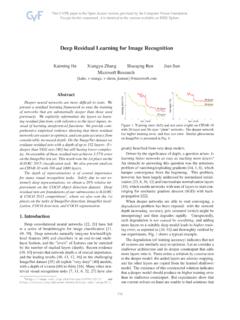Transcription of TVM: An Automated End-to-End Optimizing Compiler for …
1 TVM: An Automated End-to-End Optimizing Compiler for deep learning Tianqi Chen and Thierry Moreau, University of Washington; Ziheng Jiang, University of Washington, AWS; Lianmin Zheng, Shanghai Jiao Tong University; Eddie Yan, Haichen Shen, and Meghan Cowan, University of Washington; Leyuan Wang, UC Davis, AWS; Yuwei Hu, Cornell; Luis Ceze, Carlos Guestrin, and Arvind Krishnamurthy, University of Washington This paper is included in the Proceedings of the 13th USENIX Symposium on Operating Systems Design and Implementation (OSDI '18). October 8 10, 2018 Carlsbad, CA, USA. ISBN 978-1-939133-08-3. Open access to the Proceedings of the 13th USENIX Symposium on Operating Systems Design and Implementation is sponsored by USENIX.
2 TVM: An Automated End-to-End Optimizing Compiler for deep learning Tianqi Chen1 , Thierry Moreau1 , Ziheng Jiang1,2 , Lianmin Zheng3 , Eddie Yan1. Meghan Cowan1 , Haichen Shen1 , Leyuan Wang4,2 , Yuwei Hu5 , Luis Ceze1 , Carlos Guestrin1 , Arvind Krishnamurthy1. 1 Paul G. Allen School of Computer Science & Engineering, University of Washington 2 AWS, 3 Shanghai Jiao Tong University, 4 UC Davis, 5 Cornell Memory Subsystem Architecture Abstract CPU GPU TPU'. L2 Wgt. FIFO. There is an increasing need to bring machine learn- L3. Activation SM SM Accum. ing to a wide diversity of hardware devices. Current L2 L2 L1/TX L1/TX Bu er Register L1D L1I L1D L1I RF RF RF RF File frameworks rely on vendor-specific operator libraries implicitly managed mixed explicitly managed and optimize for a narrow range of server-class GPUs.
3 Compute Primitive Deploying workloads to new platforms such as mo- bile phones, embedded devices, and accelerators ( , FPGAs, ASICs) requires significant manual effort.. We propose TVM, a Compiler that exposes graph-level scalar vector tensor and operator-level optimizations to provide performance portability to deep learning workloads across diverse Figure 1: CPU, GPU and TPU-like accelerators re- hardware back-ends. TVM solves optimization chal- quire different on-chip memory architectures and com- lenges specific to deep learning , such as high-level op- pute primitives. This divergence must be addressed when erator fusion, mapping to arbitrary hardware primitives, generating optimized code.
4 And memory latency hiding. It also automates optimiza- tion of low-level programs to hardware characteristics by employing a novel, learning -based cost modeling method terms of memory organization, compute functional units, for rapid exploration of code optimizations. Experimen- etc., as shown in Figure 1. tal results show that TVM delivers performance across Current DL frameworks, such as TensorFlow, MXNet, hardware back-ends that are competitive with state-of- Caffe, and PyTorch, rely on a computational graph in- the-art, hand-tuned libraries for low-power CPU, mo- termediate representation to implement optimizations, bile GPU, and server-class GPUs.
5 We also demonstrate , auto differentiation and dynamic memory man- TVM's ability to target new accelerator back-ends, such agement [3, 4, 9]. Graph-level optimizations, however, as the FPGA-based generic deep learning accelerator. are often too high-level to handle hardware back-end- The system is open sourced and in production use inside specific operator-level transformations. Most of these several major companies. frameworks focus on a narrow class of server-class GPU devices and delegate target-specific optimizations to highly engineered and vendor-specific operator li- 1 Introduction braries. These operator-level libraries require significant manual tuning and hence are too specialized and opaque deep learning (DL) models can now recognize images, to be easily ported across hardware devices.
6 Providing process natural language, and defeat humans in challeng- support in various DL frameworks for diverse hardware ing strategy games. There is a growing demand to deploy back-ends presently requires significant engineering ef- smart applications to a wide spectrum of devices, rang- fort. Even for supported back-ends, frameworks must ing from cloud servers to self-driving cars and embed- make the difficult choice between: (1) avoiding graph ded devices. Mapping DL workloads to these devices is optimizations that yield new operators not in the prede- complicated by the diversity of hardware characteristics, fined operator library, and (2) using unoptimized imple- including embedded CPUs, GPUs, FPGAs, and ASICs mentations of these new operators.
7 ( , the TPU [21]). These hardware targets diverge in To enable both graph- and operator-level optimiza- USENIX Association 13th USENIX Symposium on Operating Systems Design and Implementation 579. tions for diverse hardware back-ends, we take a fun- of valid programs for a given operator declaration. (2). damentally different, End-to-End approach. We built We introduce an Automated program optimization frame- TVM, a Compiler that takes a high-level specification of work to find optimized tensor operators. The optimizer is a deep learning program from existing frameworks and guided by an ML-based cost model that adapts and im- generates low-level optimized code for a diverse set of proves as we collect more data from a hardware back- hardware back-ends.
8 To be attractive to users, TVM end. (3) On top of the automatic code generator, we needs to offer performance competitive with the multi- introduce a graph rewriter that takes full advantage of tude of manually optimized operator libraries across di- high- and operator-level optimizations. verse hardware back-ends. This goal requires addressing By combining these three modules, TVM can take the key challenges described below. model descriptions from existing deep learning frame- works, perform joint high- and low-level optimizations, Leveraging Specific Hardware Features and Abstrac- and generate hardware-specific optimized code for back- tions.
9 DL accelerators introduce optimized tensor com- ends, , CPUs, GPUs, and FPGA-based specialized pute primitives [1, 12, 21], while GPUs and CPUs con- accelerators. tinuously improve their processing elements. This poses This paper makes the following contributions: a significant challenge in generating optimized code for a given operator description. The inputs to hardware in- We identify the major optimization challenges in pro- structions are multi-dimensional, with fixed or variable viding performance portability to deep learning work- lengths; they dictate different data layouts; and they have loads across diverse hardware back-ends.
10 Special requirements for memory hierarchy. The system We introduce novel schedule primitives that take ad- must effectively exploit these complex primitives to ben- vantage of cross-thread memory reuse, novel hardware efit from acceleration. Further, accelerator designs also intrinsics, and latency hiding. commonly favor leaner control [21] and offload most We propose and implement a machine learning based scheduling complexity to the Compiler stack. For spe- optimization system to automatically explore and cialized accelerators, the system now needs to gener- search for optimized tensor operators. ate code that explicitly controls pipeline dependencies to hide memory access latency a job that hardware per- We build an End-to-End compilation and optimiza- forms for CPUs and GPUs.
